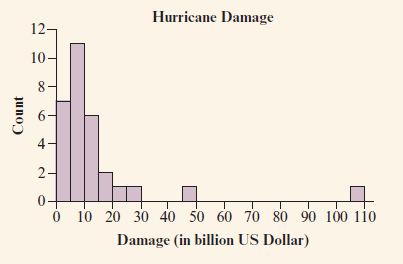Refer to the previous exercise about hurricane damage and the histogram shown there. a. For this data,
Question:
a. For this data, 93% of damages (i.e., all but the two most expensive) fall within one standard deviation of the mean. Why is this so different from the 68% the empirical rule suggests?
b. How would removing the costliest hurricane (Katrina in 2005, shown on the far right in the histogram) from the data set affect the
(i) mean,
(ii) median,
(iii) standard deviation,
(iv) IQR,
(v) 10th percentile?
Data from previous exercise
The histogram shows the distribution of the damage (in billion dollars) of the 30 most costly hurricanes hitting the U.S. mainland between 1900 and 2010. (Numbers are inflation adjusted and in 2010 dollars). The data are available in the Hurricane file on the book€™s website.

The word "distribution" has several meanings in the financial world, most of them pertaining to the payment of assets from a fund, account, or individual security to an investor or beneficiary. Retirement account distributions are among the most...
Step by Step Answer:

Statistics The Art And Science Of Learning From Data
ISBN: 9780321997838
4th Edition
Authors: Alan Agresti, Christine A. Franklin, Bernhard Klingenberg





